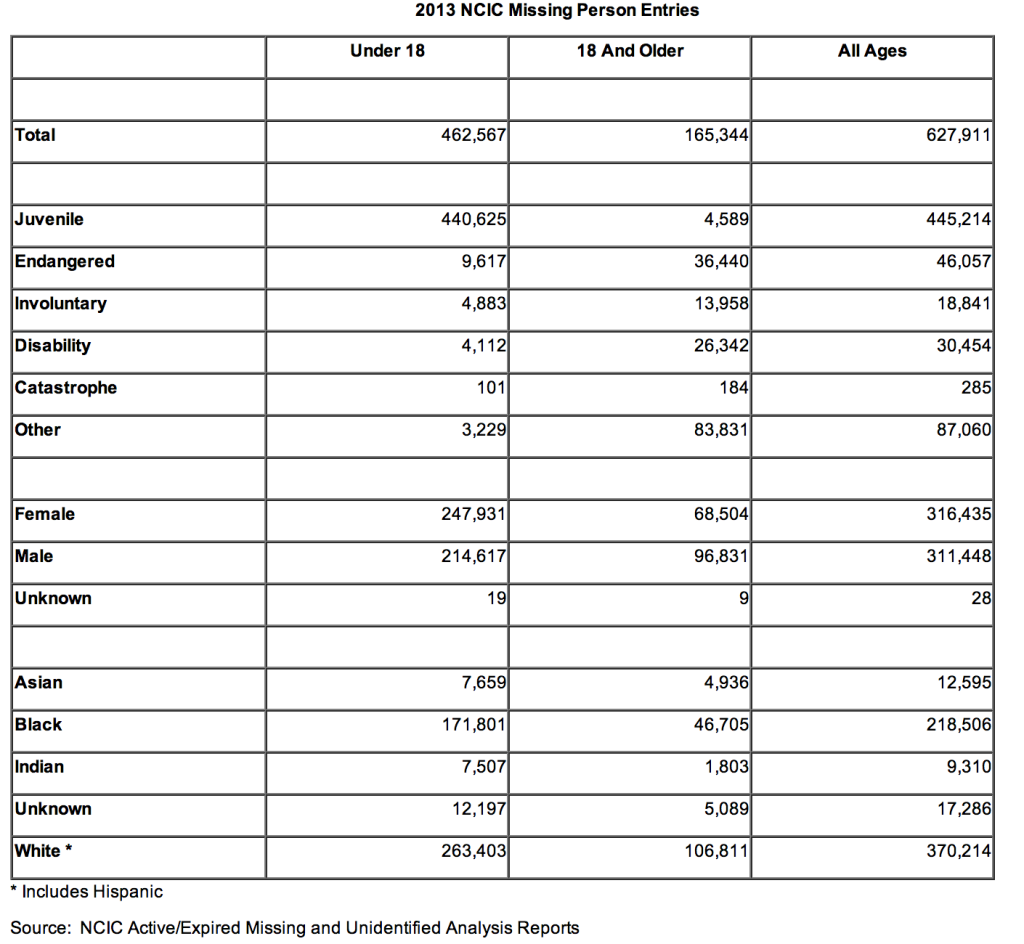The recent, ongoing abduction and sale of Nigerian school girls is one of the memes of the moment. I say this, not to demean or diminish the urgency and unjustness of the horrific kidnapping and sale of these girls as “wives.” It is heart-wrenching, nauseating, and so terribly, terribly wrong. Several hundred girls being abducted at one time is certainly newsworthy. But it took several weeks before international outrage seemed to be forthcoming about this religiously and economically motivated abduction and sale of women.
The Big Picture
This current “case” illustrates many of the classic problems encountered when research about women, children, society, and the ugly underside of our supposedly civil society is undertaken.
Try to find the number of missing school girls in the United States. Just try. There isn’t one number. We don’t know.
I googled, “How many children are missing in the U.S. at any time.” The first page of the search results returned only information about the Nigerian tragedy. That is probably because I was logged in and Google tried to interpret what I was “really” asking before it returned search results.
I then logged out of Google and entered the search again. Finally the last entry on the page, nine pages into the search results, was
Clicking this brought up a page with images of missing persons, mainly young women and children. Statistics and raw numbers were still not found without a lot more digging in the site.
Problems Encountered During the Search
This exercise in data procurement illustrates many things, including, most importantly for general knowledge about research: Google is not a good starting point for fact finding.
Another problem for those trying to find information and real data is commendably-intentioned but inaccurate citations such as this one:
“Department Of Justice has identified the top twenty human trafficking jurisdictions in the country:” Houston • El Paso • Los Angeles • Atlanta • Chicago • Charlotte • Miami • Las Vegas • New York • Long Island • New Orleans • Washington, D.C. • Philadelphia • Phoenix • Richmond • San Diego• San Francisco • St Louis • Seattle • Tampa (Department of Justice) ”
The problem with this is the link (now in red) was not to the Department of Justice, it was to a Texas-based law firm that cites supposed DOJ information but does not provide a reference or link to any DOJ information. This quote can be found all over the internet in blogs, PDFs, and even a book. I was unable to determine where this quote originated.
If you are computer and web site savvy you can link any use of a link to a page a snapshot of that page. Not a bad idea.
Statistics are usually tied to a specific moment in time and may be difficult to interpret for non-professionals. For example, this summary
As of December 31, 2013, NCIC contained 84,136 active missing person records. Juveniles under the age of 18 account for 33,849 (40.2 %) of the records and 9,706 (11.5 %) were for juveniles between the ages of 18 and 20. *
is much more easily interpreted than this chart
Reconciliation of the difference in type of numbers reported in charts and statements is not directly addressed.
The chart says 247,931 females under the age of 18 were reported missing through the FBI at some time during 2013. We know from the official NCIC/FBI statement that at a given date, December 31st, 2013 contained 33,849 missing children – both male and female.
Errors of Omission
These are official, reported missing persons. What about unofficial missing and exploited young women? Such women certainly exist. These could include youngsters who have been kicked out of their homes, runaways who family choses not to report them missing, and cases reported locally that do not make it into any “official” state or national record.
Just as with the Nigerian Islamic Fundamentalists who abducted the school girls for purportedly religious reasons, we know there are Fundamentalist groups in the United States that marry off girl children without the informed consent of the woman being married.
Religious Sects
The most notorious of recent cases would probably be the Warren Jeffs case in which the religious leader of the FLDS was found guilty and sentenced to life in prison for sexually assaulting an underage “follower” he claimed as his wife in a “spiritual marriage.” This sect continues to exist after Jeffs’ incarceration. Last year a woman, Ruby Jessop, who had been forced to marry at age 14, finally escaped from an FLDS controlled town in Northern Arizona.
While the LDS Fundamentalists get much of the attention when forced marriage of young women in the U.S. is discussed, there is a distinct coercive element within many purportedly Christian Fundamentalist sects in the U.S. which advocate complete control over all the information to which a girl child is allowed to access until she has married and control over her has been transferred from her father to her husband. Is this so very different from a forced marriage? The Nigerian abductors of the school girls believe girls should not be educated and should marry men who believe in Sharia. The differences are there in quality but not in kind.
Finding Real Data
This is why research can be a difficult endeavor for people not trained in data retrieval and interpretation. Anthropologically-informed research is based on the tendency of a member of a group to be blind to the culture within which she or he was reared.
If you want reliable data, you have to know how to find it, and to examine and explicitly mention the contexts in which it was found.
Related topics and resources that might be of interest to those intrigued by gender and sexual inequality.
Film:
Information-based Sites:
Fact Sheet (PDF):


Leave a Reply